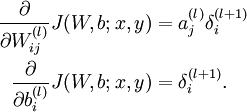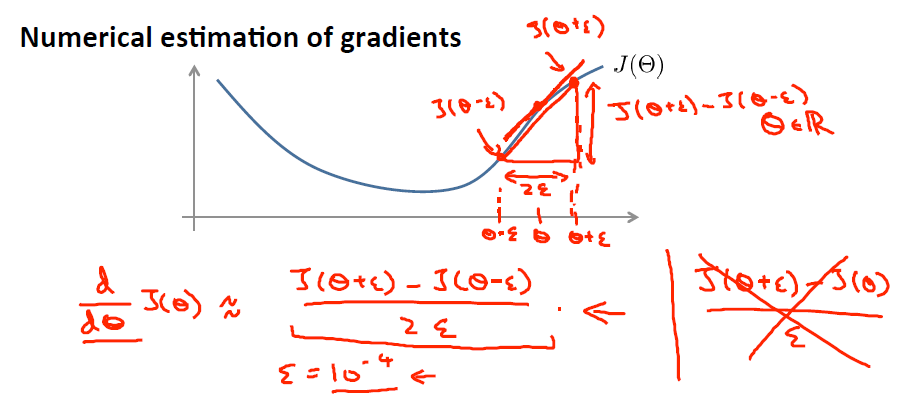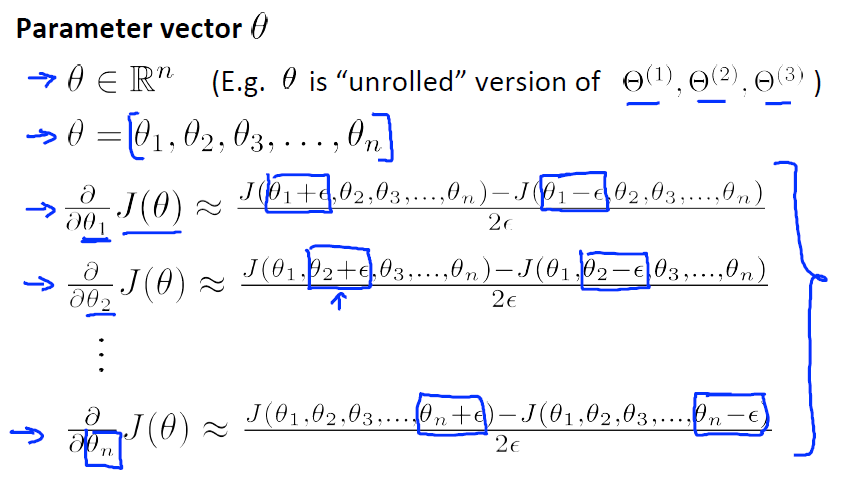CS229 6.3 Neurons Networks Gradient Checking
BP演算法很難除錯,一般情況下會隱隱存在一些小問題,比如(off-by-one error),即只有部分層的權重得到訓練,或者忘記計算bais unit,這雖然會得到一個正確的結果,但效果差於準確BP得到的結果。
有了cost function,目標是求出一組引數W,b,這裡以 表示,cost function 暫且記做
表示,cost function 暫且記做 。假設
。假設  ,則
,則  ,即一維情況下的Gradient Descent:
,即一維情況下的Gradient Descent:

根據6.2中對單個引數單個樣本的求導公式:

可以得到每個引數的偏導數,對所有樣本累計求和,可以得到所有訓練資料對引數  的偏導數記做
的偏導數記做  ,
, 是靠BP演算法求得的,為了驗證其正確性,看下圖回憶導數公式:
是靠BP演算法求得的,為了驗證其正確性,看下圖回憶導數公式:

可見有: 那麼對於任意
那麼對於任意  值,我們都可以對等式左邊的導數用:
值,我們都可以對等式左邊的導數用:
 來近似。
來近似。
給定一個被認為能計算  的函式
的函式 ,可以用下面的數值檢驗公式
,可以用下面的數值檢驗公式
應用時,通常把 設定為一個很小的常量,比如在
設定為一個很小的常量,比如在 數量級,最好不要太小了,會造成數值的舍入誤差。上式兩端值的接近程度取決於
數量級,最好不要太小了,會造成數值的舍入誤差。上式兩端值的接近程度取決於  的具體形式。假定
的具體形式。假定 的情況下,上式左右兩端至少有4位有效數字是一樣的(通常會更多)。
的情況下,上式左右兩端至少有4位有效數字是一樣的(通常會更多)。
當 是一個n維向量而不是實數時,且
是一個n維向量而不是實數時,且  ,在 Neorons Network 中,J(W,b)可以想象為 W,b 組合擴充套件而成的一個長向量
,在 Neorons Network 中,J(W,b)可以想象為 W,b 組合擴充套件而成的一個長向量 
 的函式
的函式  ,如何檢驗
,如何檢驗 能否輸出到正確結果呢,用
能否輸出到正確結果呢,用 的取值來檢驗,對於向量的偏導數:
的取值來檢驗,對於向量的偏導數:

根據上圖,對  i 求導時,只需要在向量的第i維上進行加減操作,然後求值即可,定義
i 求導時,只需要在向量的第i維上進行加減操作,然後求值即可,定義  ,其中
,其中

 和
和  幾乎相同,除了第
幾乎相同,除了第  行元素增加了
行元素增加了  ,類似地,
,類似地, 得到的第
得到的第  行減小了
行減小了  ,然後求導並與
,然後求導並與 比較:
比較:

 中的引數對應的是引數向量中一個分量的細微變化,損失函式J 在不同情況下會有不同的值(比如三層NN 或者 三層autoencoder(需加上稀疏項)),上式中左邊為BP演算法的結果,右邊為真正的梯度,只要兩者很接近,說明BP演算法是在正確工作,對於梯度下降中的引數是按照如下方式進行更新的:
中的引數對應的是引數向量中一個分量的細微變化,損失函式J 在不同情況下會有不同的值(比如三層NN 或者 三層autoencoder(需加上稀疏項)),上式中左邊為BP演算法的結果,右邊為真正的梯度,只要兩者很接近,說明BP演算法是在正確工作,對於梯度下降中的引數是按照如下方式進行更新的:
![\begin{align}
W^{(l)} &= W^{(l)} - \alpha \left[ \left(\frac{1}{m} \Delta W^{(l)} \right) + \lambda W^{(l)}\right] \\
b^{(l)} &= b^{(l)} - \alpha \left[\frac{1}{m} \Delta b^{(l)}\right]
\end{align}](http://ufldl.stanford.edu/wiki/images/math/0/f/7/0f7430e97ec4df1bfc56357d1485405f.png)
即有  分別為:
分別為:

最後只需總體損失函式J(W,b)的偏導數與上述 的值比較即可。
的值比較即可。
除了梯度下降外,其他的常見的優化演算法:1) 自適應 的步長,2) BFGS L-BFGS,3) SGD,4) 共軛梯度演算法,以後涉及到再看。
的步長,2) BFGS L-BFGS,3) SGD,4) 共軛梯度演算法,以後涉及到再看。

